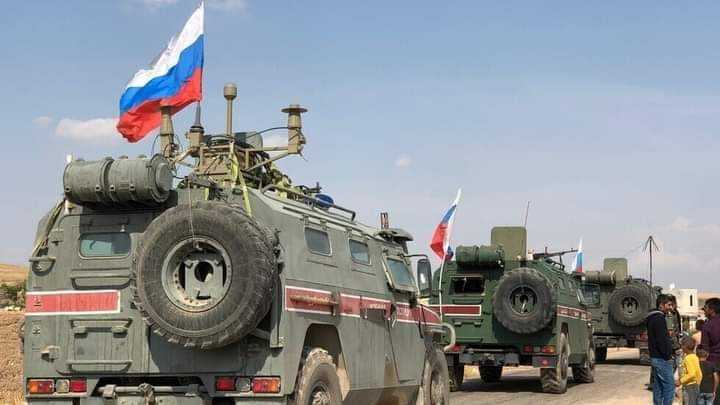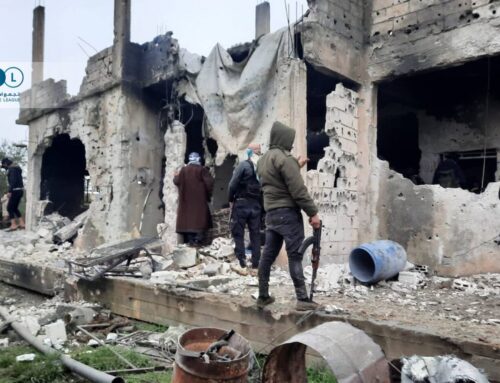Amid war in Ukraine, Russia withdraws and Iran expands in Syria
Amid the Russian invasion of Ukraine, Moscow’s forces in Syria have withdrawn and repositioned. Iran is looking to fill the gap.
4 May 2022
PARIS — Since the Russian invasion of Ukraine began on February 24, Moscow has undertaken a number of military changes in Syria and repositioned some of its forces. In return, Iran is attempting to fill the void, revealing Tehran’s strong appetite for further penetration in Syria.
Russian withdrawal
In recent weeks, Russian forces in Syria withdrew from some of their positions and regrouped elsewhere in the country, including at the Hmeimim Air Base and the Qamishli, Deir e-Zor and T4 airports. It is not clear if withdrawals from Syria to Russia or Ukraine have taken place.
Direct Russian military intervention in Syria began in September 2015. Since then, Moscow has tipped the scales in favor of the Bashar al-Assad regime and helped Damascus restore control over wide opposition-controlled areas using a scorched earth policy of airstrikes and heavy weapons bombardments as well as settlement (reconciliation) agreements. Russia sponsored settlements in southern Syria, East Ghouta, the Homs countryside and elsewhere as a guarantor.
As Russia repositions, Iran is stepping in. The latter has provided direct and indirect support to the regime since 2011, and members of the Iranian Revolutionary Guard Corps (IRGC) have had a formal presence in Syria since early 2013. An array of pro-Iran militias are also active on the ground.
In March, IRGC forces and pro-Iran militias reinforced their presence at Aleppo’s Nayrab Military Airport. Iran-backed groups such as Lebanon’s Hezbollah, Iraq’s Harakat Hezbollah al-Nujaba and Kataib Hezbollah, Afghanistan’s Fatemiyoun Division and Syria’s Baqir Brigade have also recently brought dozens of positions and areas in Aleppo province under their control.
Russian forces and the Fifth Corps, a Moscow-backed Syrian military force, also turned over the Mahin military depot east of Homs–one of the largest arms depots in Syria, containing 25 equipped warehouses—to Iran-backed militias and Hezbollah in early April after withdrawing to the Palmyra Military Airport. In mid-April, the same forces withdrew from the airport as well, also in favor of Iran-backed militias. Moscow did not announce any of these withdrawals officially or through its affiliated media.
Military expert and former Syrian army Brigadier General Ahmad Rahal called the Russian withdrawals “an urgent need, after sinking in the Ukrainian quagmire.” As a result of large Russian losses in Ukraine, “Moscow has lightened its presence in Syria as part of its current strategy, since the more important battle for it is in Ukraine, and not in Syria,” Rahal told Syria Direct.
While stressing that Russia’s withdrawal in Syria is linked to what is happening in Ukraine, military and strategic analyst and defected Syrian Colonel Mustafa al-Farhat said that “Russia’s withdrawals are not limited to Syria. It withdrew a portion of its forces deployed on several fronts in Ukraine to push them into the second stage of the battle there.”
Russia’s military presence in Syria—consisting of a few thousand soldiers, military police, and Wagner Group fighters—is limited compared to the estimated 100,000 soldiers involved in the war in Ukraine. But Moscow needs its forces coming from Syria “to push them into its decisive battle in Ukraine, benefiting from their combat and bombing experience,” al-Farhat said.
For his part, Russian researcher Kirill Semenov, an independent analyst and expert at the Moscow-based Russian International Affairs Council (RIAC), said Russia’s intervention in Syria in recent years was “to counter attempts to expand Iran’s influence in Syria, fearing it would be the one most involved in the Iranian confrontation with the United States and Israel.” As a result, Moscow found itself forced to “contain Iran in Syria.”
But “after Russia found itself in conflict with the United States, and Israel ended up taking an anti-Moscow and pro-Ukraine stance,” Semenov said, Moscow felt that it “is not necessary to abide by the old rules.”
An opportunity to strengthen Iran’s role
Three days after Russia invaded Ukraine, the head of the regime’s National Security Bureau, Ali Mamlouk, met in Tehran with the secretary of Iran’s Supreme National Security Council, Ali Shamkhani, as well as Iranian President Ebrahim Raisi.
While the stated aim of the visit, according to Iranian media, was to discuss bilateral relations and regional and international developments and the “destructive” American presence in Syria, the visit of a prominent regime security figure at such a time has additional dimensions.
The regime may have sought, through Mamlouk’s visit, to strengthen Iran’s role in the face of what may result from a decline of Russia’s role in Syria. That reading is made likely by Tehran stating, through Shamkhani’s words, the need to “accelerate the agreements” between the two countries. This could be read as Iran’s determination to penetrate further into Syria militarily and economically, taking advantage of the international community’s preoccupation with Ukraine.
Moscow does not seem to mind Damascus relying more on Tehran, especially since Russian forces have previously vacated a number of positions in favor of pro-Iran militias. For Russia, “Iran is the best one to occupy the areas Russian forces withdrew from until Putin finishes his battle with Ukraine,” al-Farhat said.
He predicted that Putin would return to Syria “with strength” if “he wins his battle in Ukraine,” adding that “coordination, cooperation and an exchange of interests between the two parties [Russia and Iran] is natural.” The regime “does not have enough forces to deploy them in the areas of Russian withdrawal,” he said.
But Tehran appears to have gone further than planned. “The Iranians seized the opportunity, they are the most opportunistic,” Rahal said. Their incursion has not dispelled the fears of a regime “extremely horrified by the Russian withdrawal, especially since the Iranians alone are incapable of confrontation in the absence of air power.”
Iranian penetration
In addition to Tehran occupying points that Moscow withdrew from after the invasion of Ukraine, Iran, through its militias, has reinforced its presence at more than 120 sites and military headquarters in the Syrian Desert. Reinforcements included some 4,500 personnel, missile platforms, weapons, drones, and communication devices, the London-based newspaper Asharq Al-Awsat reported.
In March, the IRGC also opened the door to volunteers in exchange for a monthly salary of SYP 200,000 ($52 according to the parallel market exchange rate of SYP 3,870 to the dollar), stipulating that volunteers work in the Syrian Desert. Tehran recruits Syrians on the grounds of religion, ideology and region. It started doing so soon after the Syrian revolution broke out in March 2011, and has helped establish and support dozens of sectarian militias. Iran-backed Hezbollah also participated in suppressing popular protests against Bashar al-Assad.
In this context, an Iranian delegation and Syrian regime officers met with a notable of the Tayy tribe last month at Qamishli airport in northern Syria in order to establish an Iranian-funded military council. The council, to be composed of members of the region’s tribes, would stand against the US-backed Syrian Democratic Forces (SDF) in the region, according to the Syrian Observatory for Human Rights (SOHR).
Additionally, Hezbollah seized the Zamla al-Mahr 1 oil field in the Homs desert in late March and turned it into a military headquarters after expelling state employees from the site. The field had been discovered months ago by the Syrian Ministry of Oil and Mineral Resources.
Syria’s south has seen cautious and indirect moves by Iran, especially since the region is ruled by a Russian-Israeli agreement to keep Iran and its militias away from border areas with Israeli territory. Tehran’s moves have come in the shape of the Syrian regime making several changes to the heads of security branches in the province, reinforcing Iran’s influence there.
The changes began following the late February assassination of Maher Wassouf, a major in the Political Security Directorate and the official responsible for the Nassib border crossing with Jordan. Wassouf was appointed by the Presidential Palace months ago against the backdrop of Amman’s objections to drug smuggling through the crossing.
Following Wassouf’s assassination, fingers were pointed at pro-Iranian forces in the area, which lead drug smuggling operations. Wassouf’s appointment had been a blow to them, as the volume of smuggled contraband declined. Major Yahya Mayya, head of the Political Security detachment in the Daraa countryside town of Izraa, was appointed as Wassouf’s successor to head up the Nassib crossing. Mayya is known for his loyalty to Iran and strong relationship with pro-Iran militias in Daraa.
In March, the head of the Security Committee in Daraa, Major General Mufid al-Hassan, also known for his loyalty to Iran, made several changes to the leadership of security branches in the province. He appointed Brigadier General Bassam Shehadeh as head of General Intelligence in Daraa, replacing Brigadier General Oqab Saqr, and named Colonel Samer Suwaydan head of the Political Security branch in Daraa, replacing Colonel Osama al-Asaad. Both the new officials are known for their affiliation with the Iranian current, which “confirms the strengthening of the Iranian presence and penetration into Daraa,” a military source formerly in the opposition factions in Daraa told Syria Direct.
The future of allies
For more than two years, Iranian militias have worked to dig tunnels in Syria’s eastern Deir e-Zor province for the transport and storage of weapons, Syrian opposition and international media have reported. Satellite images have also indicated tunnel construction in the eastern province.
Tunneling is “ongoing,” a Syrian media source close to Harakat Hezbollah al-Nujaba told Syria Direct. “Quality weapons continue to arrive, and they are stored underground to avoid US and Israeli airstrikes.”
Iranian militias are also working to “spread rocket launchers and shoulder-mounted, surface-to-air missiles among residential neighborhoods in Deir e-Zor villages and towns,” the same source said.
Tehran’s recent attempts to reinforce its strength and conceal its weapons coincides with “the absence of a Russian strategy, since it is preoccupied with Ukraine,” al-Farhat said. Moscow aims to “stabilize what exists, and prevent opposition forces from advancing until the end of its war with Ukraine,” he added.
That could result in “Iran rebelling and expanding, weakening Russia’s hand in Syria,” according to Rahal. Consequently, Moscow may decide to “unburden itself and withdraw permanently from Syria, or reduce its force,” which would give more space to Iran.
But while Iran’s chances of strengthening its role in the future seem great, its inability to “make up for Russian air cover” will likely prevent Damascus and Tehran “from confronting the Free [Syrian] Army, SDF or other forces,” Rahal added, with this inability increased by Israel’s continuous bombings of Iranian military targets in Syria.
This report was originally published in Arabic and translated into English by Mateo Nelson.







